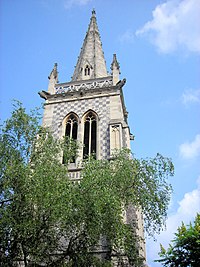St Mary-le-Tower
| St Mary-le-Tower | |
|---|---|
| Saint Mary-le-Tower church | |
 The tower of the church | |
| 52°03′30″N 1°09′19″E / 52.0584°N 1.1554°E | |
| Location | Ipswich, Suffolk |
| Country | England |
| Denomination | Church of England |
| Churchmanship | Central |
| Website | http://www.stmaryletower.org/ |
| History | |
| Dedication | Saint Mary |
| Architecture | |
| Heritage designation | Grade II* |
| Designated | 19 December 1951 |
| Specifications | |
| Spire height | 176 feet (54 m) |
| Administration | |
| Diocese | Diocese of St Edmundsbury and Ipswich |
Ipswich Minster, also known as St Mary-le-Tower, is the civic church of Ipswich, Suffolk, England and a Grade II* listed building.[1][2] It was in the churchyard of St Mary that the town charter of Ipswich was written in 1200.[3]
History
[edit]Although medieval, the church mostly dates from 1860 to 1870, when it was rebuilt by Richard Phipson.[4] Rebuilding was funded by George Bacon, banker and philanthropist. St Mary Le Tower is mentioned in the Domesday Book, demonstrating that the site has been occupied by a church since at least 1086.[5]
Memorials
[edit]The church contains a brass memorial on a chancel pier to H.A. Douglas-Hamilton, vicar from 1915 to 1925. There are also four brasses in the chancel floor.
Organ
[edit]The church has a large three-manual pipe organ, which has its origins in an instrument by Renatus Harris of 1690.[6] There was subsequent work by Henry Willis, Spurden Rutt and Bishop and Son. A specification of the organ can be found on the National Pipe Organ Register.[7]
Bells
[edit]Originally there were five bells and a Sanctus in 1553 of which Miles Graye I of Colchester recast the Treble in 1607 and the Tenor in 1610. The church was the first in Suffolk to achieve a tower a peal of 12 bells in 1865. With the addition of a sharp second in 1980, the current bells are all by John Taylor of Loughborough (except for No. 7, which is by Mears & Stainbank of London).
Incumbents
[edit]- Thomas Peacock 1542
- John Somerton 1555
- George Webb 1577 - 1606
- Nathaniel Roe 1608 - 1614
- Mr Nuttall 1615
- John Ward 1616 - 1620
- John Gooding 1620 - 1624
- Samuel Ward 1624 - 1627
- Mr Skinner 1628 - 1630
- Mr Raymond 1630 - 1632
- Samuel Ward 1632 - 1635
- John Ashborn 1635 - 1636
- Gawen Nash 1637 - 1641
- William Fincham 1649
- Mr Chapman ???? - 1662
- John Burrough 1662 - 1670
- Hugh Roberts 1670 - 1672
- Samuel Brunning 1674 - 1677
- Samuel Gotty 1677
- Joseph Cutlove 1678 - 1707
- Dr. Thomas Bishop 1708 - 1737
- Thomas Bishop 1737 - 1777
- Thomas Cobbold 1778 - 1831, grandson of Thomas Cobbold (1708–1767)
- Francis Cobbold 1831 - 1838, succeeded his father
- William Nassau St Leger 1838 - 1860
- Joames Robert Thurrock 1861 - 1890
- Afthil Arthur Barrington 1890 - 1904
- William Melville Pigot 1904 - 1914
- Hamilton Anne Douglas-Hamilton 1915 - 1925
- Arthur William Watson Wallace MA 1925 - 1928
- Arthur Herbert Streeten MC MA 1928 - 1942
- Richard Hamilton Babington MA 1942 - 1958
- Basil Layton Spurgin MA 1958 - 1972
- Geoffrey John Tarris MA 1972 - 1982
- Keith Brynmor Jones MA 1982 - 1996
- Peter Kenneth Townley BA. 1996 - 2008
- Charles Alexander Graham Jenkin, BSc 2008 - 2021
- Thomas James Mumford 2021 -
See also
[edit]References
[edit]- ^ official website
- ^ Historic England. "Church of St Mary le Tower (1235800)". National Heritage List for England. Retrieved 13 August 2019.
- ^ St Mary Le Tower, Suffolk Churches website
- ^ The Buildings of England; Suffolk. Nikolaus Pevsner. Yale University Press. ISBN 9780300096484
- ^ "St. Mary-le-Tower, Ipswich | 267586". Emporis. Archived from the original on 28 January 2015. Retrieved 3 May 2022.
{{cite web}}: CS1 maint: unfit URL (link) - ^ The Organ, its History and Construction. Hopkins & Rimbault. 1st Ed: 1855
- ^ "The National Pipe Organ Register - NPOR".


